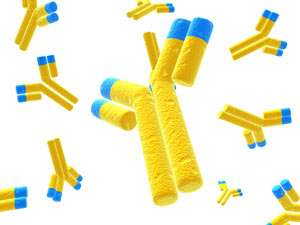Efficient, high-quality monoclonal antibody production is made possible through use of self-cleaving peptides. Credit: Sebastian Kaulitzki/Hemera/Thinkstock
Using self-cleaving peptides, A*STAR researchers have designed a vector that improves efficiency for monoclonal antibody production, offering potential for improved preclinical studies.
The production of monoclonal antibodies, such as Immunoglobulin G, involves linking large and small polypeptide antibody subunits—heavy and light chain genes. "Balancing the ratio of heavy and light chain expression is essential for high-level and quality antibody expression," explains Yuansheng Yang from the A*STAR Bioprocessing Technology Institute.
Current industrial methods for producing antibodies, in which light-chain, heavy-chain and selection marker genes are delivered either on separate vectors or a single vector with multiple promoters, are unable to accurately balance light and heavy chain gene expression. This tends to result in many non-expressing cells.
Using self-cleaving proteins such as 2A peptides, which are commonly derived from viruses, to express the genes seemed a promising alternative to the plasmid vectors favored by industry, "2A peptides enable co-expression of multiple genes at equal amounts by expressing them in one open reading frame," explains Yang. But, while 2A peptides can produce antibodies, incomplete cleavage of 2A can result in the formation of incorrect antibodies that cannot be properly folded and form high molecular aggregates.
Recognizing the potential of these species for monoclonal antibody production, Yang and the team searched for 2A peptides with higher cleavage efficiencies and then developed purification methods to remove incorrect antibody species in instances of incomplete 2A peptide cleavage.
The researchers compared four 2A peptides, both in the presence and absence of glycine-serine-glycine linkers, used to express three bio-similar Immunoglobulin G 1 monoclonal antibodies in Chinese hamster ovary cell lines via transient and stable transfections.
They found that the inclusion of the glycine-serine-glycine linkers significantly enhanced the cleavage efficiency and the monoclonal antibody expression level for each 2A peptide. T2A, the 2A peptide derived from the Thosea asigna virus, with the gylcine-serine-glycine linker had the highest cleavage efficiency, and when combined with Furin (Furin-GSG-T2A) was most effective for IgG antibody expression.
Although more cleavage efficient, 2A peptides with the glycine-serine-glycine linkers still had some degree of incomplete cleavage, resulting in incorrect antibodies. The team tried to remedy this with a purification method they had previously developed, the chromatin-directed clarification. "We expected the removal of incorrect species in the high molecular aggregates," Yang says. "The removal of the incorrect species contained in the IgG monomer, however, was very surprising as there is only a few amino acids difference between that and the correct antibody."
More information: "Cleavage efficient 2A peptides for high level monoclonal antibody expression in CHO cells." mAbs 7, 403–412 (2015). www.tandfonline.com/doi/abs/10 … 1008351#.VezuAvmqpBc





















